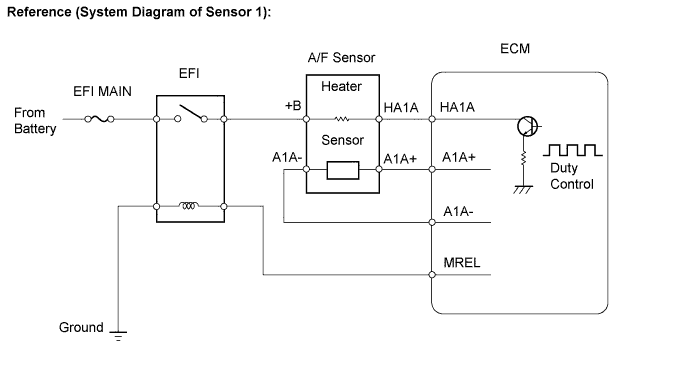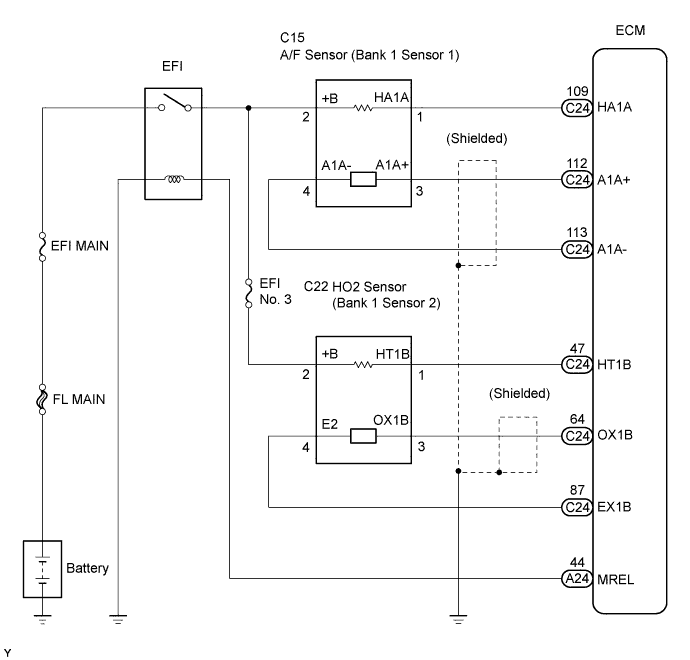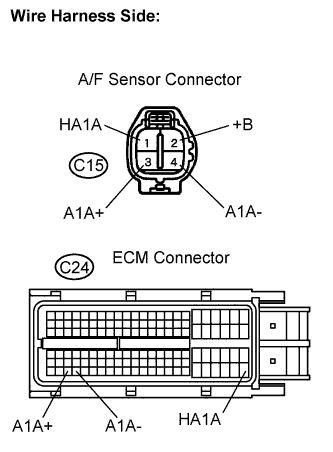Engine. Camry. Acv40 Gsv40
2Az-Fe Engine Control System. Camry. Acv40 Gsv40
CHECK HARNESS AND CONNECTOR (A/F SENSOR - ECM)
CHECK WHETHER DTC OUTPUT RECURS
DTC P2237 Oxygen (A/F) Sensor Pumping Current Circuit / Open (Bank 1 Sensor 1) |
DTC P2238 Oxygen (A/F) Sensor Pumping Current Circuit Low (Bank 1 Sensor 1) |
DTC P2239 Oxygen (A/F) Sensor Pumping Current Circuit High (Bank 1 Sensor 1) |
DTC P2252 Oxygen (A/F) Sensor Reference Ground Circuit Low (Bank 1 Sensor 1) |
DTC P2253 Oxygen (A/F) Sensor Reference Ground Circuit High (Bank 1 Sensor 1) |
- HINT:
- Although the DTC titles say oxygen sensor, these DTCs relate to the Air-Fuel Ratio (A/F) sensor.
- Sensor 1 refers to the sensor mounted in front of the Three-Way Catalytic Converter (TWC) and located near the engine assembly.
DESCRIPTION
These DTCs are set when there is an open or short in the A/F sensor circuit, or if A/F sensor output drops. To detect these problems, the voltage of the A/F sensor is monitored when the ignition switch is turned to the ON position, and the admittance (admittance is an electrical term that indicates the ease of flow of current) is checked while driving. If the voltage of the A/F sensor is between 0.6 V and 4.5 V, it is considered normal. If the voltage is out of the specified range, or the admittance is less than the standard value, the ECM will determine that there is a malfunction in the A/F sensor. If the same malfunction is detected in next driving cycle, the MIL will be illuminated and a DTC will be stored.The A/F sensor, which is located between the exhaust manifold and catalyst, consists of alloyed metal elements and a heater.
Depending on the engine operating conditions, the heater heats the sensor elements to activate them. Battery voltage is applied to the heater, the sensor ground is controlled by the ECM using a duty ratio.
The sensor elements convert the oxygen concentration in the exhaust gas into voltage values to output. Based on the voltage, the ECM determines the air-fuel ratio and regulates the fuel injection volume depending on the air-fuel ratio and engine operating conditions. The voltage changes between 0.6 V and 4.5 V while the engine is running. If the air-fuel ratio is LEAN, which means the oxygen concentration in the exhaust gas is high, the voltage is high. If the air-fuel ratio is RICH, which means the oxygen concentration in the exhaust gas is low, the voltage is low.


| DTC No. | DTC Detection Conditions | Trouble Areas |
| P2237 | Open in the circuit between terminals AF+ and AF- of the AF sensor while engine is running (2 trip detection logic) |
|
| P2238 | Any of the following conditions are met (2 trip detection logic)
|
|
| P2239 | AF+ voltage more than 4.5 V (2 trip detection logic) |
|
| P2252 | AF- voltage 0.5 V or less (2 trip detection logic) |
|
| P2253 | AF- voltage more than 4.5 V (2 trip detection logic) |
|
WIRING DIAGRAM

INSPECTION PROCEDURE
- HINT:
- Intelligent tester only:
- Malfunctioning areas can be identified by performing the "Control the Injection Volume for A/F Sensor" function provided in the Active Test. The "Control the Injection Volume for A/F Sensor" function can help determine whether the Air-Fuel Ratio (A/F) sensor, Heated Oxygen (HO2) sensor and other potential trouble areas are malfunctioning.
- Connect the intelligent tester to the DLC3.
- Start the engine and turn the tester on.
- Warm up the engine at an engine speed of 2,500 rpm for approximately 90 seconds.
- On the tester, select the following menu items: Powertrain / Engine and ECT / Active Test / Control the Injection Volume for A/F Sensor.
- Perform the "Control the Injection Volume for A/F Sensor" operation with the engine idling (press the RIGHT or LEFT button to change the fuel injection volume).
- Monitor the output voltages of the A/F and HO2 sensors (AFS B1 S1 and O2S B1 S2) displayed on the tester.
- HINT:
- The "Control the Injection Volume for A/F Sensor" operation lowers the fuel injection volume by 12.5 % or increases the injection volume by 25 %.
- The sensors react in accordance with increases and decreases in the fuel injection volume.
- Standard:
Tester Display
(Sensor)Injection Volume Status Voltages AFS B1 S1
(A/F)+25 % Rich Less than 3.0 -12.5 % Lean More than 3.35 O2S B1 S2
(HO2)+25 % Rich More than 0.5 -12.5 % Lean Less than 0.4
- NOTICE:
- The A/F sensor has an output delay of a few seconds and the HO2 sensor has a maximum output delay of approximately 20 seconds.
| Case | A/F Sensor (Sensor 1) Output Voltage | HO2 Sensor (Sensor 2) Output Voltage | Main Suspected Trouble Areas | ||
| 1 | Injection Volume +25 % -12.5 % |  | Injection Volume +25 % -12.5 % |  | - |
| Output Voltage More than 3.35 V Less than 3.0 V |  | Output Voltage More than 0.5 V Less than 0.4 V |  | ||
| 2 | Injection Volume +25 % -12.5 % |  | Injection Volume +25 % -12.5 % |  |
|
| Output Voltage Almost no reaction |  | Output Voltage More than 0.5 V Less than 0.4 V |  | ||
| 3 | Injection Volume +25 % -12.5 % |  | Injection Volume +25 % -12.5 % |  |
|
| Output Voltage More than 3.35 V Less than 3.0 V |  | Output Voltage Almost no reaction |  | ||
| 4 | Injection volume +25 % -12.5 % |  | Injection Volume +25 % -12.5 % |  |
|
| Output Voltage Almost no reaction |  | Output Voltage Almost no reaction |  | ||
- Following the A/F CONTROL procedure enables technicians to check and graph the output voltages of both the A/F and HO2 sensors.
- To display the graph, select the following menu items on the tester: Powertrain / Engine and ECT / Active Test / Control the Injection Volume for A/F Sensor / Enter / View / AFS B1 S1 and 02S B1 S2.
- HINT:
- Read freeze frame data using the intelligent tester. The ECM records vehicle and driving condition information as freeze frame data the moment a DTC is stored. When troubleshooting, freeze frame data can help determine if the vehicle was moving or stationary, if the engine was warmed up or not, if the air-fuel ratio was lean or rich, and other data from the time the malfunction occurred.
| 1.CHECK HARNESS AND CONNECTOR (A/F SENSOR - ECM) |
Disconnect the C15 A/F sensor connector.
 |
Disconnect the C24 ECM connector.
Measure the resistance between the terminals of the wire harness side connectors.
- Standard resistance (Check for open):
Tester Connection Specified Condition A1A+ (C15-3) - A1A+ (C24-112) Below 1 Ω A1A- (C15-4) - A1A- (C24-113) Below 1 Ω
- Standard resistance (Check for short):
Tester Connection Specified Condition A1A+ (C15-3) or A1A+ (C24-112) - Body ground 10 kΩ or higher A1A- (C15-4) or A1A- (C24-113) - Body ground 10 kΩ or higher
Reconnect the ECM connector.
Reconnect the A/F sensor connector.

|
| ||||
| OK | |
| 2.REPLACE AIR-FUEL RATIO SENSOR |
| NEXT | |
| 3.CHECK WHETHER DTC OUTPUT RECURS |
Connect the intelligent tester to the DLC3.
Turn the ignition switch to the ON position and turn the tester on.
Clear the DTCs (CAMRY_ACV40 RM000000PDK0D5X.html).
Start the engine.
Allow the engine to idle for 5 minutes or more.
Select the following menu items: Powertrain / Engine and ECT / DTC.
Read pending DTCs.
- Result:
Display (DTC Output) Proceed to No output A P2237, P2238, P2239, P2252 or P2253 B
|
| ||||
| A | ||
| ||